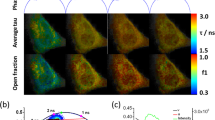Abstract
Fluorescence resonance energy transfer (FRET)1 detection in fusion constructs consisting of green fluorescent protein (GFP)2 variants linked by a sequence that changes conformation upon modification by enzymes or binding of ligands has enabled detection of physiological processes such as Ca2+ ion release3, and protease4,5,6,7 and kinase activity8. Current FRET microscopy techniques are limited to the use of spectrally distinct GFPs such as blue or cyan donors in combination with green or yellow acceptors. The blue or cyan GFPs have the disadvantages of less brightness and of autofluorescence. Here a FRET imaging method is presented that circumvents the need for spectral separation of the GFPs by determination of the fluorescence lifetime of the combined donor/acceptor emission by fluorescence lifetime imaging microscopy (FLIM)9,10,11,12. This technique gives a sensitive, reproducible, and intrinsically calibrated FRET measurement that can be used with the spectrally similar and bright yellow and green fluorescent proteins (EYFP/EGFP), a pair previously unusable for FRET applications. We demonstrate the benefits of this approach in the analysis of single-cell signaling by monitoring caspase activity in individual cells during apoptosis.
This is a preview of subscription content, access via your institution
Access options
Subscribe to this journal
Receive 12 print issues and online access
$209.00 per year
only $17.42 per issue
Buy this article
- Purchase on Springer Link
- Instant access to full article PDF
Prices may be subject to local taxes which are calculated during checkout



Similar content being viewed by others
References
Förster, T. Zwischenmolekulare Energiewanderung und Fluoreszenz. Ann. Phys. (Leipz.) 2, 55–75 (1948).
Pollok, B.A. & Heim, R. Using GFP in FRET-based applications. Trends Cell Biol. 9, 57–60 (1999).
Miyawaki, A. et al. Fluorescent indicators for Ca2+ based on green fluorescent proteins and calmodulin. Nature 388, 882–887 (1997).
Heim, R. & Tsien, R.Y. Engineering green fluorescent protein for improved brightness, longer wavelengths and fluoresence resonance energy transfer. Curr. Biol. 6, 178–182 (1996).
Mitra, R.D., Silva, C.M. & Youvan, D.C. Fluorescence resonance energy transfer between blue-emitting and red-shifted excitation derivatives of the green fluorescent protein. Gene 173, 13–17 (1996).
Xu, X. et al. Detection of programmed cell death using fluorescence energy transfer. Nucleic Acids Res. 26, 2034–2035 (1998).
Mahajan, N.P., Harrison-Shostak, D.C., Michaux, J. & Herman, B. Novel mutant green fluorescent protein protease substrates reveal the activation of specific caspases during apoptosis. Chem. Biol. 401–409 (1999).
Nagai, Y. et al. A fluorescent indicator for visualizing cAMP-induced phosphorylation in vivo. Nat. Biotechnol. 18, 313–316 (2000).
Squire, A. & Bastiaens, P.I.H. Three dimensional image restoration in fluorescence lifetime imaging. J. Microsc. 193, 36–49 (1999).
Clegg, R.M., Feddersen, B.A., Gratton, E. & Jovin, T.M. Time resolved imaging fluorescence microscopy. Proc. SPIE 1640, 448–460 (1992).
Gadella Jr, T.W.J., Jovin, T.M. & Clegg, R.M. Fluorescence lifetime imaging microscopy (FLIM)—spatial resolution of microstructures on the nanosecond time-scale. Biophys. Chem. 48, 221–239 (1993).
Lakowicz, J.R. & Berndt, K. Lifetime-selective fluorescence imaging using an rf phase-sensitive camera. Rev. Sci. Instrum. 62, 1727–1734 (1991).
Tan, X., Martin, S.J., Green, D.R. & Wang, J.Y.J. Degradation of retinoblastoma protein in tumor necrosis factor- and CD95-induced cell death. J. Biol. Chem. 272, 9613–9616 (1997).
Martin, S.J., O'Brien, G.A., Nishioka, W.K. & McGahon, A.J. Proteolysis of fodrin (non-erythroid spectrin) during apoptosis. J. Biol. Chem. 270, 6425–6428 (1995).
Lazebnik, Y.A., Kaufmann, S.H., Desnoyers, S. & Poirier, G.G. Cleavage of poly(ADP-ribose) polymerase by a proteinase with properties like ICE. Nature 371, 346–347 (1994).
Nicholson, D.W., Ali, A., Thornberry, N.A. & Vaillancourt, J.P. Identification and inhibition of the ICE/CED-3 protease necessary for mammalian apoptosis. Nature 376, 37–43 (1995).
Casciola-Rosen, L.A., Miller, D.K., Anhalt, G.J. & Rosen, A. Specific cleavage of the 70-kDa protein component of the U1 small nuclear ribonucleoprotein is a characteristic biochemical feature of apoptotic cell death. J. Biol. Chem. 269, 30757–30760 (1994).
Pepperkok, R., Squire, A., Geley, S. & Bastiaens, P.I.H. Simultaneous detection of multiple green fluorescent proteins in live cells. Curr. Biol. 9, 269–272 (1999).
Littlewood, T.D., Hancock, D.C., Danielian, P.S., Parker, M.G. & Evan, G.I. A modified oestrogen receptor ligand-binding domain as an improved switch for the regulation of heterologous proteins. Nucleic Acids Res. 23, 1686–1690 (1995).
Hueber, A.O. et al. Requirement for the CD95 receptor–ligand pathway in c-Myc-induced apoptosis. Science 278, 1305–1309 (1997).
Acknowledgements
The authors would like to thank Gerard Evan and David Hancock of the Biochemistry of the Cell Nucleus Laboratory, Imperial Cancer Research Fund, for the Rat-1/c-mycER fibroblasts.
Author information
Authors and Affiliations
Corresponding author
Rights and permissions
About this article
Cite this article
Harpur, A., Wouters, F. & Bastiaens, P. Imaging FRET between spectrally similar GFP molecules in single cells. Nat Biotechnol 19, 167–169 (2001). https://doi.org/10.1038/84443
Received:
Accepted:
Issue Date:
DOI: https://doi.org/10.1038/84443
This article is cited by
-
Rational design of genetically encoded reporter genes for optical imaging of apoptosis
Apoptosis (2020)
-
A FRET biosensor for necroptosis uncovers two different modes of the release of DAMPs
Nature Communications (2018)
-
Guidelines on experimental methods to assess mitochondrial dysfunction in cellular models of neurodegenerative diseases
Cell Death & Differentiation (2018)
-
Recent advances in M13 bacteriophage-based optical sensing applications
Nano Convergence (2016)
-
Fluorescent-protein-based probes: general principles and practices
Analytical and Bioanalytical Chemistry (2015)



